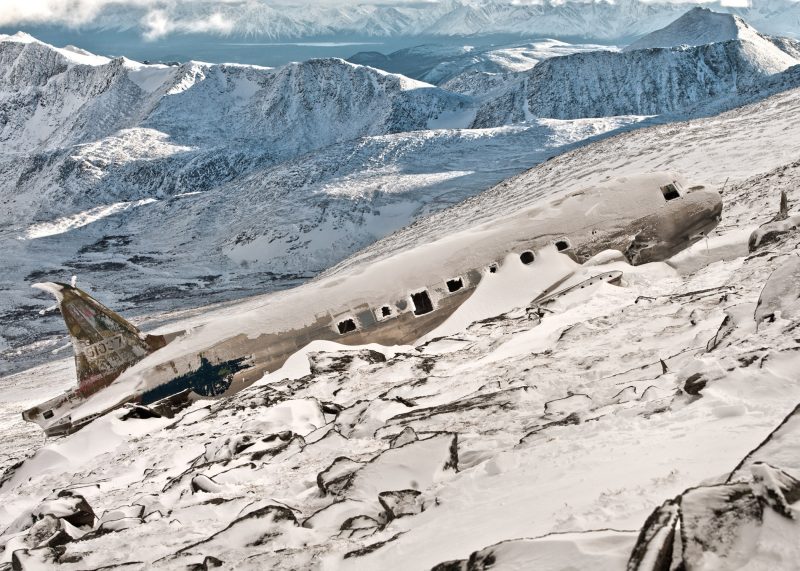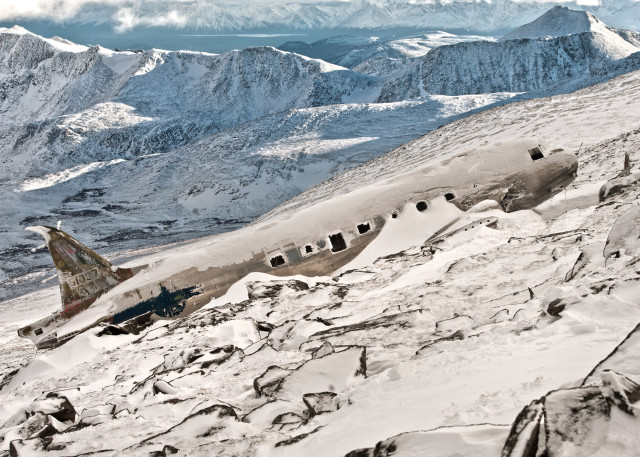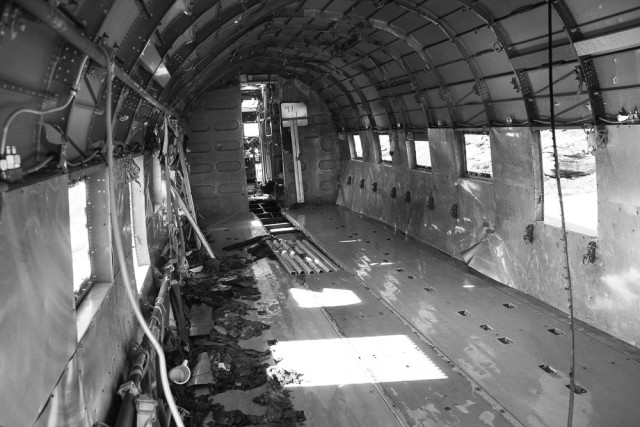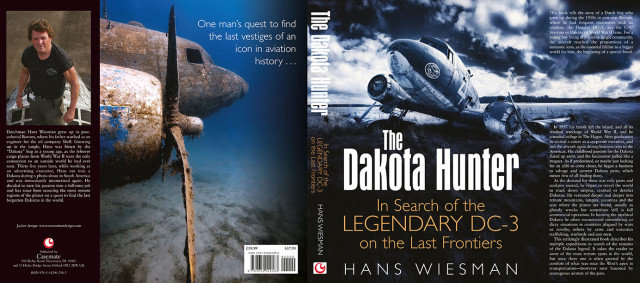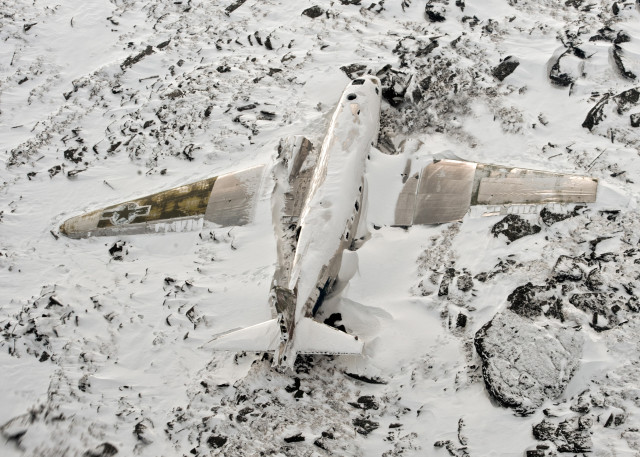 Photo above: Flying low over the McClintoc mountain range, 25 miles south-west of Whitehorse YT, this USAF C-47 had participated in the S & R operations for the missing C-54 since weeks. In snow covered mountains, any crashed aircraft would be extremely hard to spot due to the camouflaging effects of fresh snow (see photo above). Flying lower than the previous days over the ridges and hoping to detect any debris, they suddenly entered an air pocket with the effect “as if the floor had dropped out from beneath us, We were caught and just couldn’t get out”, the 28-year-old pilot described later, trying to explain the sudden near-fatal sinking of the aircraft.
Photo above: Flying low over the McClintoc mountain range, 25 miles south-west of Whitehorse YT, this USAF C-47 had participated in the S & R operations for the missing C-54 since weeks. In snow covered mountains, any crashed aircraft would be extremely hard to spot due to the camouflaging effects of fresh snow (see photo above). Flying lower than the previous days over the ridges and hoping to detect any debris, they suddenly entered an air pocket with the effect “as if the floor had dropped out from beneath us, We were caught and just couldn’t get out”, the 28-year-old pilot described later, trying to explain the sudden near-fatal sinking of the aircraft.
They bounced upon initial contact, struck again against the slope and slid to a stop while turning 90 degrees to the left. Regarding the huge boulders that were all around in the terrain ( see photo below), they were extremely lucky as most of the obstacles were covered in thick snow. The aircraft remained almost intact in its antics and slide over the slope. Only the radio operator was wounded by the incoming runaway propeller that penetrated the fuselage skin just behind the co-pilot’s seat. It was the sudden sinking that most likely saved his life.”I got halfway out of my seat when we hit. A propeller came into the fuselage and broke my leg. If I ‘d still been in my seat, it would have killed me”, he said. Another crew member had a chest injury, but the rest of the crew stepped out without injuries, a miracle by itself.
For more fabulous photos of this Yukon USAF crashed C-47, see also my first blog about this incident: Vol.1 of the Yukon Crash site with dramatic pics. It was so far the best-visited Blog that I made in the first year of my online Blog writing, published on the walls of multiple Facebook groups and on US-based ” War History Online” Magazine.
This Vol. II gives more details and more fabulous photos of that epic crash, probably one of the luckiest crashes in the rich 80 years long DC-3 history.
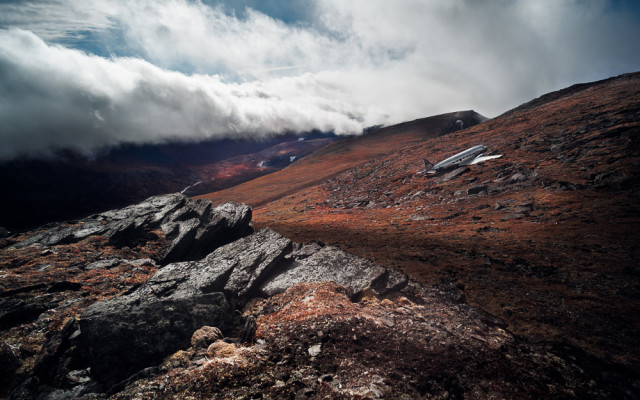 The dramatic photo above is made by my friend Felix Stadler, who made all alone a most adventurous 5-day hike to this almost magical crash site and met the Grizzly and early snow storms on his way up from Whitehorse.
The dramatic photo above is made by my friend Felix Stadler, who made all alone a most adventurous 5-day hike to this almost magical crash site and met the Grizzly and early snow storms on his way up from Whitehorse.
I visited the crash site some years earlier and went there (in more comfort) by helicopter from Haines Junction, next to the Kluane National Park. I describe my trip to this place in my book The Dakota Hunter ( see below) and compared the wreck with that of the Titanic, an untouchable relic. It is a monument out there, an almost intact time capsule that exists since 1950, in a surrounding and a material state as I have never seen with any other crashed aircraft.
This is a magical place, like an Inca Graveyard that I once visited in the High Andes in Peru with a similar bizarre game of breaking light and sudden dark, caused by the eternal battle of storm clouds and sun rays in high mountains. In Peru, we found the grave of a young girl, mummified, here in the Yukon I found the grave of a C-47/ Dakota, mummified! For more of Felix’ fabulous photos, see also my first blog Vol. I and his harrowing hike report with more photos Felix Hike to the Crash site
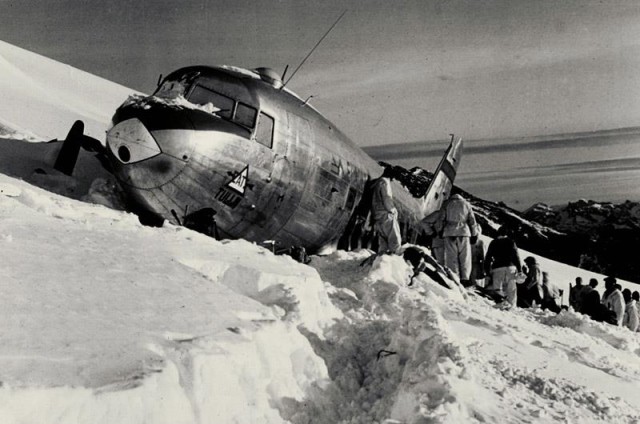 Photo above: By sheer coincidence, another USAF C-53 Skytrooper was involved in an almost similar accident on 18 November 1946. It took place in the Swiss Alps with an aircraft that came from Vienna, Austria and was on its way to Pisa, Italy. The aircraft collided with the Gauli Glacier in poor visibility in which the pilots became disoriented. As you can see in the photo, there was relatively low damage on the aircraft and there were no fatalities.
Photo above: By sheer coincidence, another USAF C-53 Skytrooper was involved in an almost similar accident on 18 November 1946. It took place in the Swiss Alps with an aircraft that came from Vienna, Austria and was on its way to Pisa, Italy. The aircraft collided with the Gauli Glacier in poor visibility in which the pilots became disoriented. As you can see in the photo, there was relatively low damage on the aircraft and there were no fatalities.
The lost plane was spotted in the Alps by an RAF Lancaster and by a B-29 Super Fortress that flew at 16.000 feet over the glacier! On 23 November at 2:20 PM, two Swiss soldiers on ski reached the stricken aircraft and its passengers after a 13-hour ascent, but as it was too late for a descent on the same day. It was decided to wait at the wreck overnight, enduring temperatures of 5 °F (−15 °C). The next day, everybody descended towards the Alpine Club Gauli hut at 7,234 ft (2,205 m). At 10.20 AM, 2 Swiss Air Force pilots managed to land two Fieseler Storch aircraft on the glacier beside the rescuers, and with eight flights, everybody was flown to safety. (Note: that same type of aircraft had been used in the spectacular escape of the Italian dictator Mussolini from the Gran Sasso Mountain Ski Resort, Italy in September 1943, ordered by Hitler and executed by German SS Troopers!) (sources: Wikipedia)
What you see on the photo above, it must have been a similar scene with the rescue of the Yukon crashed C-47. Heavy snow covering a slightly inclined slope side which has played the role of an effective natural airbag. That clearly helped the crew in the survival of the initial impact inflicted by the terrain collision.
Photo above: current cabin interior of the stricken Yukon C-47. Over the years, the site has been visited by a limited number of curious people and by pros that came for recovering of the useful parts. As I stepped inside, the floor was very slippery from the hydraulic oil, still everywhere. Under the floor plating, partly removed, I found a canvas military boot.( Photo Felix Stadler).
In the case of the Yukon C-47 crash, things were a bit more complicated. The aircraft’s tanks had been broken open on impact and all was soaked with petrol but luckily, there was no fire. The crew had to spend the first night inside the smelly cabin (smoking inside was not allowed and we must presume that no one would have had the guts to challenge that order). It gave the shattered crew a welcome refuge to counter the cold with temperatures around 30 degrees below zero. The stricken aircraft was spotted by another Dakota Search plane. Soon foods, sleeping bags and a walkie-talkie were dropped to the survivors, who would have to spend 3 days on the desolate mountain before being rescued by a helicopter.
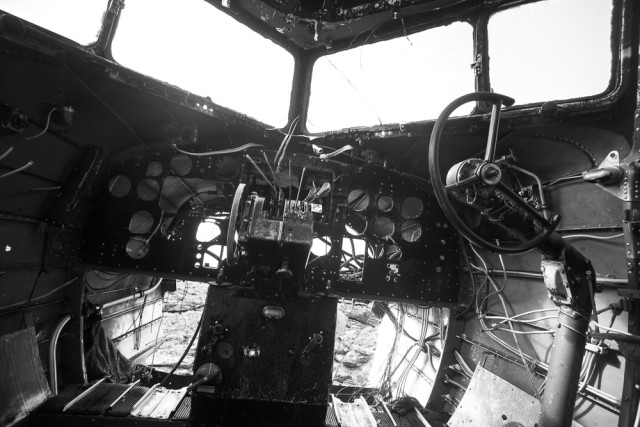 Photo above; The cockpit was professionally stripped, most probably done by Pros who flew in shortly after the crash for recovery of components. They came in with special tools by helicopter, dismantled the nose cone, most instruments, RH wingtip, rudder and lifted the both P & W R-1830 engines from their nacelles. What remains is a near empty shell but the skin of that shell is in an outstanding condition. Due to the high winds, low temps. and in spite of a very moist atmosphere but with the total lack of salt, the aluminium skin is “as new”. All paint faded or gone, treated to the point of a mirror polished finish. Never seen such condition of aluminium after 60+ years in open air.( Photo Felix Stadler)
Photo above; The cockpit was professionally stripped, most probably done by Pros who flew in shortly after the crash for recovery of components. They came in with special tools by helicopter, dismantled the nose cone, most instruments, RH wingtip, rudder and lifted the both P & W R-1830 engines from their nacelles. What remains is a near empty shell but the skin of that shell is in an outstanding condition. Due to the high winds, low temps. and in spite of a very moist atmosphere but with the total lack of salt, the aluminium skin is “as new”. All paint faded or gone, treated to the point of a mirror polished finish. Never seen such condition of aluminium after 60+ years in open air.( Photo Felix Stadler)
On 10 February 1950, a para-rescue team of 6 men ( including a doctor) jumped to the crash site. They helped the 10 survivors to get to a provisional rescue camp, set up down the mountain side. There they met the composite rescue party of Canadian and US Army personnel, who had fought up their way through the snow-covered rocky terrain with the use of a “Weasel” half-track vehicle (see photo below).
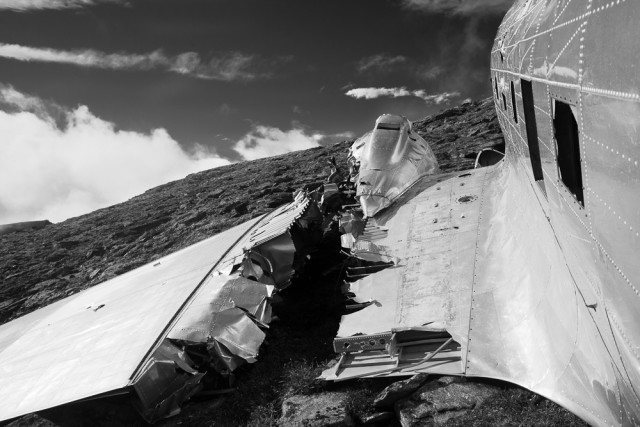 Photo above: ( Felix Stadler) The C-47 shows very limited structural damage after the crash collision against the hill. With its fuselage fully intact, only the left hand wing shows a serious crack with separation from the air frame. If this would have happened during the final slide over the slope, you would expect the wing to be in a more rearward position. Not so, it is exactly still in situ, as if she broke off at the very last moment, due to a “tilting” of the aircraft in the final swing over the left, that might have lifted up the aircraft on the right-hand side only, “hinging” the lower wing to this crack. Another option, considering the very straight cuttings of the stringers, maybe they had a plan to airlift the main wing and was the fissure caused by tools? Let me know what you think!
Photo above: ( Felix Stadler) The C-47 shows very limited structural damage after the crash collision against the hill. With its fuselage fully intact, only the left hand wing shows a serious crack with separation from the air frame. If this would have happened during the final slide over the slope, you would expect the wing to be in a more rearward position. Not so, it is exactly still in situ, as if she broke off at the very last moment, due to a “tilting” of the aircraft in the final swing over the left, that might have lifted up the aircraft on the right-hand side only, “hinging” the lower wing to this crack. Another option, considering the very straight cuttings of the stringers, maybe they had a plan to airlift the main wing and was the fissure caused by tools? Let me know what you think!
The last stage of the rescue of the crew was done by a helicopter, flying them 15 miles south to Pon Lake. From there, an RCAF Dakota ferried them 45 miles back to Whitehorse, where all were taken to local hospitals. The helicopter lifting had to be suspended due to the running out of daylight and one final crew member was taken out only the next day.
Yet another C-47 had crashed a week earlier ( it was surely an epidemic Crash Time for USAF, see also my blog about USAF horror year). 1 Lt. Charles Harden, the injured pilot, decided in a very audacious move, to leave his shelter behind and go for help, heading all alone to the south on foot. He waded for 6 hours through waist-deep snow and bush. After marching a stunning 13 km, he hit the Carcross Road, west of the crash site. Two civilians found him and drove the pilot to Whitehorse, from where the rescue of his crew mates could be organised the next day. With so many serious accidents during S & R operations, the Military had to seriously reconsider the briefings and training of crews. Recommendations were made to all search crews that emphasised: “to be thoroughly briefed to the proper methods of conducting an aerial search and briefed in the techniques and dangers of flying over mountainous terrain.”
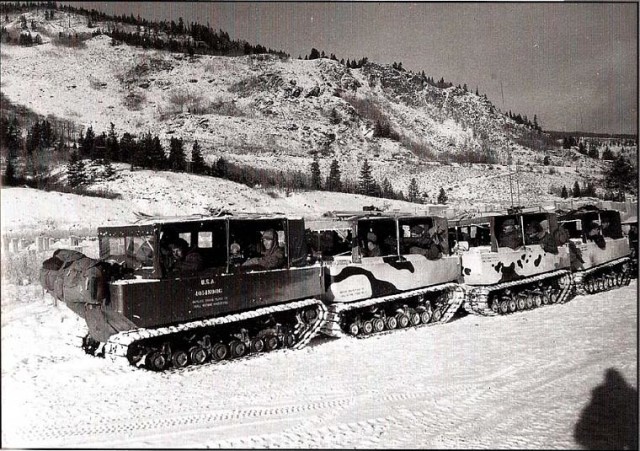 Photo above depicts the Weasels M29 made by Studebaker. Four of the Weasels were deployed in the Yukon C-47 Rescue operation. Three of them had broken down after they lost their tracks while crossing the Aishinik River (aka Canyon Creek), lower down in the valley. The rescue team pressed on with a single machine and made it to the provisional camp near the crash site. The Weasel was originally intended to be used for a planned invasion of Norway but ended up in many hotspots of the war, including in Normandy during the invasion of D-Day, June 1944.
Photo above depicts the Weasels M29 made by Studebaker. Four of the Weasels were deployed in the Yukon C-47 Rescue operation. Three of them had broken down after they lost their tracks while crossing the Aishinik River (aka Canyon Creek), lower down in the valley. The rescue team pressed on with a single machine and made it to the provisional camp near the crash site. The Weasel was originally intended to be used for a planned invasion of Norway but ended up in many hotspots of the war, including in Normandy during the invasion of D-Day, June 1944.
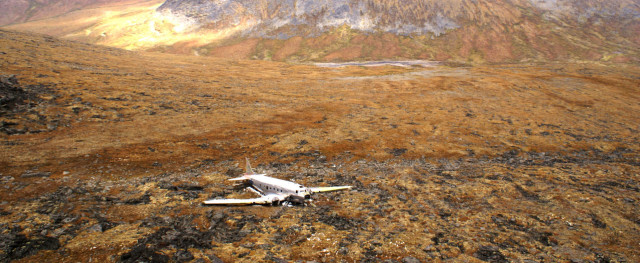 Photo above, (courtesy Julie le Bolzer, copyrights The Dakota Hunter) shows the Yukon wreck in all her glory, this is how we spotted her from the Helicopter. I describe my findings in my book “The Dakota Hunter” and have found a number of new aspects about the full story, also thanks to my “Blog co-producers” Dirk Septer and Felix Stadler, who supplied photos and their stories. If interested to read more of such fascinating stories, I invite you to take a look at the information below aboutmy book and my blogs.
Photo above, (courtesy Julie le Bolzer, copyrights The Dakota Hunter) shows the Yukon wreck in all her glory, this is how we spotted her from the Helicopter. I describe my findings in my book “The Dakota Hunter” and have found a number of new aspects about the full story, also thanks to my “Blog co-producers” Dirk Septer and Felix Stadler, who supplied photos and their stories. If interested to read more of such fascinating stories, I invite you to take a look at the information below aboutmy book and my blogs.
In the book The Dakota Hunter, you will read most intriguing stories about the last and lost Dakotas but also Catalinas, Connie’s, Curtiss Commandos and DC -7’s of this world, crashed, abandoned or still flying. I truly met so many of them, the 320 pages/ 250 photos (most never published before) give evidence of the multiple salvaging expeditions that I made over 20 years to Alaska, the Caribbean, Venezuela, Honduras, Brazil, Thailand, Africa, Madagascar, The Yukon, Bolivia and Colombia, the Amazon region where I still found the Dakota operational in flocks. Private Collectors and Museums in search of cockpits, instruments and spares soon found their way to me and with that, my trade was born.
This fully illustrated and engagingly written book (see the book’s jacket below) surely is a most attractive present for yourself or friends who can appreciate adventurous tales and history of vintage piston prop aircraft. You can order the bookstraightaway, only a mouse click away if you go to this Amazon link for ordering and reading reviews of my book.
For more info, a sneak preview, reviews and chapters of the book, come to my website dc3dakotahunter.com, where you can also read my previous blog posts.
If you like this blog post, please give it a like by subscribing to my Blog posts. If you have any remarks, photos, facts about the post-war career of the Dakota/ DC-3/ C-47 that can add positively to this report, please send your email to me via my website contact. I welcome your ideas, photos and submissions for new fascinating subjects (also of other vintage aircraft) to be used in my future blogs about war history and vintage aviation of the 1940’s / 1950’s.
Cheers, Hans Wiesman/ The Dakota Hunter.
Last week, a remarkable report was published in the SA Sunday Times. In a full 2 pages report. It is from the hand of Paul Ash, a most interesting review for all who are interested in the DC-3/ C-47/ Dakota history, illustrated with a couple of fascinating photos, taken from my book.
Click here to read The Sunday Times review of The Dakota Hunter.
